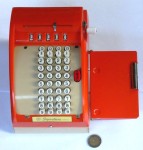
The Signature Junior Adding and Multiplying Machine
Video
Advertisements and articles
Patents
Links
The Signature Junior is a toy adding machine sold by Montgomery Ward in the late 1960s. The machine mostly is made of thin metal plate, similar to the Add-em or Peter Pan, though its upper casing is made of orange plastic. It was invented by Shigeaki Kuramochi and made in Japan by Soken. Montgomery Ward used the Signature Junior brand for the top of the range toys, which also included a sewing machine, a typewriter, and a record player.
This adding machine looks like a minature cash register. It has a 5-digit register at the top, which can be reset by turning the crank on the right hand side anti-clockwise. The curved keyboard has four full columns of keys, numbered top to bottom from 0 to 9, with a totals button to the right. After entering a number on the keyboard including leading zeroes, you press the totals button to activate the electric motor which adds the number to the register. The electric motor is powered by two size D torch batteries. On the right is a fold-out memo table, which has a hole for storing the pencil that came with the machine.
My machine comes with its original box.
It came with a single page instruction sheet, plus a small slip of paper with extra instructions for doing multiplications. There should also be a sticker on the memo-table with a brief version of the instructions, but this is not present on mine.
The mechanism is relatively simple, and reminiscent of what is used in the first Burroughs adding machines. Pressing the Total button causes two things to happen. The axle holding the gears that drive the number wheels is lifted away from the number wheels, disconnecting them, and the electric motor is triggered. The motor drives a wheel that pushes a set of spring-loaded arms back and forth along the underside of the keyboard. Any depressed key will block an arm from moving further. Just as the arms start their return journey, the gears are reconnected, so that the number wheels are moved an amount proportional to the distance that the arms travelled on their return, namely the number entered on the keyboard. The carry mechanism consists of a set of switches. The moving arms normally rest against those switches when they return, but when a number wheel passes 9 it triggers the next switch, rotating it away from the arm, and this allows the arm to move back a little bit further than normal, which adds an extra 1 to its digit. The carry switches are reset the next time the Totals button is pressed.
The instruction sheet says:


PRINTED IN JAPAN
It is not clear why the instruction sheet calls it the B/O Adding and Multiplying Machine. It has been sold under the name Brainy-Mate, but it is possible that it was given other names too, especially if it was also exported to countries other than the United States.
285×34235 × 34 1140 855 9690 |
First, push down 0285 on Numeral Button Panel and press "TOTAL" Button four times consecutively. (1140 will appear on the SCOREBOARD). Leaving this figure on the SCOREBOARD, push down 2350 and press "TOTAL" Button three times. The correct answer 9690 will appear on the SCOREBOARD then. |
Following the pattern shown above, you can carry out any multiplying indicated as follows.
Any single number (1-9) × (1 to 9999)
Any two column number (10-99) × (1 to 999)
Exercise:
76×24= (0076×4) + (0760×2) = 1824
487×36= (0487×3) + (4870×3) = 17532
999×99= (0999×9) + (9990×9) = 98901
Note: Always multiply larger number by smaller number.
Printed in Japan
Here is a video where I demonstrate the Signature Junior Adding Machine.
The only advertisements that I have found for this machine are from the 1966 to 1968 Montgomery Ward Christmas catalogues. The price was just under $10.
| Patent | Filing date | Publish date | Name | Description |
|---|---|---|---|---|
| US 3,300,130 | 06-12-1965 | 24-01-1967 | Shigeaki Kuramochi | Toy Adding Machine |
© Copyright 2020 Jaap Scherphuis, mechcalc a t jaapsch d o t net.